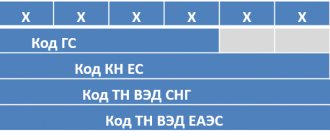HomeCustoms clearance Commercial consignment
Our company “Universal Cargo Solutions” provides the services of a customs broker (customs representative) and carries out prompt customs clearance of cargo and goods for customs clearance upon import.
or
clearance for export
, commercial consignments of any participants in foreign trade activities: legal entities, individual entrepreneurs (IP) and individuals, including goods for personal use.
A commercial consignment is a consignment of goods imported from abroad or exported abroad by a participant in foreign economic activity for the purpose of commercial gain (possibly gratuitous transfer of goods, as free samples, etc.). Such activities can only be carried out by legal entities or individual entrepreneurs. Individuals can move goods only for personal use – non-commercial shipments.
Features of registration of commercial consignments of goods
Individual: can send abroad or receive goods and parcels from abroad in accordance with the current customs code and Decision No. 107 for personal use only! These are recognized as parcels or shipments with up to 3 pieces of the same name and are used by an individual for personal purposes. Thus, customs considers a commercial consignment of goods of more than 3 pieces of the same article, size or model, but sometimes it is possible to prove that this is a non-commercial consignment (for example, socks, underwear and other goods for personal use). For example, an individual cannot order spare parts for industrial machines or receive or send a list of product samples of various models and names; such batches will be classified by customs as commercial supplies and can only be processed with the adjustment of the foreign trade participant from an individual to a legal entity or individual entrepreneur - individual entrepreneur . If your parcel is recognized as a commercial shipment and is detained by the customs authority, then, as a rule, the individual receives a notification from customs, which implies a written declaration of goods in electronic form. In some cases, it is possible to prove a non-commercial consignment of goods by an individual for personal use in personal presence at the customs office. You can also look at the list of goods not related to personal use by an individual and the definition automatically assigned by customs as a commercial consignment, even if 1 piece (unit) of goods is imported or exported! For more details, see customs clearance of individuals.
List of goods not related to personal use
If you move a commercial consignment of goods in accompanied luggage or hand luggage (by plane, car, train, etc.) across the customs border and do not inform the customs authority, then if detected by customs, this consignment will be detained and placed on temporary storage. A protocol on an administrative offense for detained or seized goods will be drawn up, after which an independent customs expert will assess the amount of detained goods, from which a fine of 0.5 to 2 times the value of the cargo will be imposed. This entire procedure can take from 1 to 2 months. And only after paying the fine, you can take back or declare the imported goods, most likely with a change of recipient to a legal entity or individual entrepreneur! Therefore, it is very important to understand which batches of goods are considered commercial and which are non-commercial.
Was the parcel recognized as a commercial shipment? – We will help you!
Examples of parcels of individuals detained by customs and recognized as a commercial consignment of goods and their possibility of registration
Example 1: The parcel contains 3 phones of the same model.
Customs recognizes them as a commercial shipment and they will most likely be sent back, because...
they are subject to mandatory certification on the territory of the EAEU, and many manufacturers of this equipment have intellectual property registered in the Russian Federation, which allows only certain companies to import these products! They are unlikely to give you such an import permit! Example 2:
Clothes of different sizes of the same model (article) were purchased an online store . This product is subject to mandatory certification (with the provision of a Declaration of Conformity - DS).
Registration of these goods is possible only with a change of recipient to a legal entity or individual entrepreneur with the provision of this certificate, or sending back to the sender. Example 3: You ordered 1 piece of hair dye of different articles (colors) and the sender wrote “sample” in the documents.
In this case, registration is possible only by changing the recipient to a legal entity or individual entrepreneur, or sending it back to the sender!
Legal entity or individual entrepreneur: can draw up commercial lots or non-commercial lots in any quantity in accordance with the shipping documents for the goods. With the provision of the necessary documents to customs: invoice, contract, waybills, necessary certificates, etc. Read more about customs clearance or customs clearance of commercial consignments of legal entities or individual entrepreneurs.
Quantitative characteristics of goods: single copies, batch, commonality and difference
Category: Fundamentals of merchandising
The quantitative characteristic is one of the fundamental ones; when determining it, the following quantitative gradations should be distinguished: single copies and their totality - product lots, complex packaging units and sets of goods. Single copy - individual goods that have integrity and consumer properties inherent to a specific type or name. Different instances with a certain degree of reliability should have the same properties. Single copies of goods can be industrial products (a car, a pair of shoes, a wheel of cheese), or biological objects (an egg, fish, watermelon), as well as packaging units in which the commodity mass is characterized by solidity and integrity (a block of butter, a bottle wine, can of paint). Single copies do not include packaging units consisting of individual products (a box or pack of cookies, a box of nails), since they themselves are complex packaging units - a collection of single copies of identical goods, united by common packaging. Such a unit differs from a commodity lot only in its smaller size and more often serves as an object for small-scale wholesale trade. A consignment is a collection of single copies of goods, or complex packaging units (of the same type and name), combined according to a certain characteristic. The sign may be: 1) a single change in production; 2) the presence of one accompanying document. All goods and single copies, batches of goods have general and specific characteristics. General characteristics: mass, length, temperature, volume, thermal conductivity, heat capacity. Specific characteristics: bulk density, porosity, strength, hardness. Physical properties: general: 1) mass (quantity of goods in a certain volume in kg, g): a) absolute mass - individual for each individual specimen; b) average weight - number of pieces, for a single specimen. 2) length - an indicator of the quality of individual goods; 3) volume - value, characteristic for liquid goods; 4) temperature - depends on ambient temperatures; 5) heat capacity - the amount of heat required to increase the temperature in an object of a certain mass. Depends on the chem. composition and temperatures; 6) thermal conductivity - the amount of heat that passes through the mass of an object of a certain thickness. It is assumed that all goods in a consignment as parts of a whole have the same properties. However, even keeping in mind a batch of industrial products with guaranteed quality, we can only talk about the identity of the properties of individual copies of the same name, produced at the same enterprise. Particular differences between them are due to the heterogeneity of natural raw materials, as well as a number of production factors (the degree of mechanization and automation of technological processes, personnel qualifications, quality of labor). Such heterogeneity requires the establishment of a certain acceptable range of quantitative characteristics. The situation is even more complicated with a consignment consisting of natural objects; biological or mineral. The degree of heterogeneity of single copies of goods in such a batch increases many times, since in nature there are no two completely identical objects.
Quantitative characteristics
refers to one of the fundamental ones, when determining it, the following quantitative gradations should be distinguished: single copies and their totality - product lots, complex packaging units and sets of goods.
Single copy
- individual goods that have integrity and consumer properties inherent to a specific type or name. Different instances with a certain degree of reliability should have the same properties.
Single copies of goods can be industrial products (a car, a pair of shoes, a wheel of cheese), or biological objects (an egg, fish, watermelon), as well as packaging units in which the commodity mass is characterized by solidity and integrity (a block of butter, a bottle wine, can of paint).
Single copies do not include packaging units consisting of individual products (a box or pack of cookies, a box of nails), since they themselves are complex packaging units - a collection of single copies of identical goods, united by common packaging. Such a unit differs from a commodity lot only in its smaller size and more often serves as an object for small-scale wholesale trade.
Product lot
- a set of single copies of goods, or complex packaging units (of the same type and name), combined according to a certain characteristic. The sign may be:
1) single production shift;
2) the presence of one accompanying document.
All goods and single copies, batches of goods have general and specific characteristics. General characteristics:
mass, length, temperature, volume, thermal conductivity, heat capacity.
Specific characteristics
:
bulk density, porosity, strength, hardness.
Physical properties:
general:
1) weight
(quantity of goods in a certain volume in kg, g):
a) absolute mass - individual for each individual specimen;
b) average weight - number of pieces, for a single specimen.
2) length
— indicator of the quality of individual goods;
3) volume
- size, characteristics for liquid goods;
4) temperature
- depends on ambient temperatures;
5) heat capacity
- the amount of heat required to raise the temperature in an object of a certain mass. Depends on the chem. composition and temperatures;
6) thermal conductivity
- the amount of heat that passes through the mass of an object of a certain thickness.
It is assumed that all goods in a shipment, as parts of a whole, have the same properties. However, even keeping in mind a batch of industrial products with guaranteed quality, we can only talk about the identity of the properties of individual copies of the same name, produced at the same enterprise. Particular differences between them are due to the heterogeneity of natural raw materials, as well as a number of production factors (the degree of mechanization and automation of technological processes, personnel qualifications, quality of labor).
Such heterogeneity requires the establishment of a certain acceptable range of quantitative characteristics. The situation is even more complicated with a consignment consisting of natural objects: biological or mineral. The degree of heterogeneity of single copies of goods in such a batch increases many times, since in nature there are no two completely identical objects.
Single copies
- individual goods that have integrity and consumer properties inherent to a specific type or name. Different instances, with a certain degree of reliability, must have the same properties. However, it is impossible to achieve absolute equivalence, therefore the totality of single copies—the product lot—is characterized by heterogeneity.
Quantitative characteristics of goods
- a set of certain intraspecific properties expressed using physical quantities and units of measurement. Characterizes the satisfaction of the need for goods of certain sizes and in certain quantities.
Set of goods
- a set of single copies of dissimilar goods that are compatible and/or interchangeable and have the same functional purpose. The kit may include products that complement each other or replace individual parts of already finished products. For example, a set of clothes (suit: trousers and/or skirt, jacket), furniture (set), dishes (service), spare parts (wheels for cars, screws and glass for furniture, etc.). In addition, sets of goods with a low degree of readiness for consumption (use) may consist of individual parts intended for the manufacture of finished products from them (for example, a set of parts for cabinet furniture, cutting for clothing, etc.).
Gross weight
- weight of packaging and products in it.
Net weight
— mass of consumer goods excluding packaging.
Nominal quantity of goods
— quantity of goods indicated on the packaging.
Product lot
- a set of single copies of goods and/or complex packaging units (of the same type and name), combined according to a certain characteristic.
“Fake” packaging
- packaging that by its appearance gives a false impression of the amount of contents, which is more than 30% of the volume is not filled with goods (with the exception of gift and souvenir sets).
Packaged goods in packages
- goods that are packaged and sealed in the absence of the buyer, while the contents of the package cannot be changed without opening or deforming it, and the weight, volume, length or other quantities indicating the quantity of goods contained in the package are indicated on the package.
Services for registration of a commercial consignment of goods at customs, cost and terms
Do you need to clear a commercial shipment at customs? We will make every effort to help you!
The specialists of our company “Universal Cargo Solutions” provide customs brokerage services and carry out customs clearance of commercial consignments of both recognized individuals detained by customs and legal entities for commercial activities! The processing time usually takes no more than 1 day!
As a rule, the price or cost of the commercial consignment registration service depends on the place of customs clearance, the complexity of the order, additional services and on average can be:
- For individuals, the cost of registration services is 1000-10000 rubles.
- For legal entities 5000-15000 rub.
We try to help every client!
What is the global difference between a batch and a series?
Actually, the answer is already contained in the question, but let’s formulate it in detail:
- By certifying the conformity of a product lot, the applicant (manufacturer or seller) guarantees that all products from that particular lot meet the established requirements.
- By confirming the conformity of mass-produced products, the applicant (only the manufacturer) guarantees that all specified products produced by him during a certain period (validity period of the permit) comply with the established requirements.
That is, the document for serial production confirms the compliance not only of the product, but also of the production
: that it successfully operates a management system that monitors the safety and quality of its products. That is why, with a “serial” confirmation of conformity, the applicant can only be the manufacturer (or his authorized person), and with a “batch” confirmation, both the importer and the seller.
It is also important to mention that when assessing the conformity of a product lot, that same lot must be clearly identified. First of all - quantitatively. Therefore, when submitting an application, in addition to other documents, it is necessary to provide a specification or invoice, which clearly indicates the size of the lot.
This leads to specific differences in certification or declaration procedures, which are best considered within the framework of these procedures themselves.
Differences between batch and batch certificates
Firstly, when certifying a batch of products, no analysis of the state of production is carried out. Product testing only.
Secondly, the validity period of a certificate for serial production is usually 5 years, while for a batch, as a rule, certificates do not expire (more precisely, until the batch is sold). The exact deadlines are specified in specific technical regulations.
Thirdly, after issuing a certificate for a batch of products, periodic inspection control is not carried out. Actually, because there is nothing to inspect here.
Draw up a document for serial production or batch?
Of course, there is no correct answer here, because everything depends on the business nuances of a particular manufacturer, importer, distributor and their relationships with each other.
And this, by the way, is an excellent example of one of the questions to which we are looking for answers for our clients as part of certification support. We study all the nuances, calculate costs and analyze risks to help the client make an informed choice based on objective data, and not on subjective recommendations.
But, despite all the uncertainty of choice, there are two factors that should be taken into account when making a decision: “proximity” to the product.
"Proximity" to the manufacturer
One extreme is that the manufacturer is located somewhere far beyond the borders of the EAEU and does not particularly make contact with the importer. Obviously, in this case there can be no talk of checking production and, as a consequence, issuing a document for serial production - only for a batch. And it’s also good if the manufacturer sends the importer the necessary technical documentation.
The other is that the manufacturer is willing to make contact and agrees to any checks for the legal sale of its products. In this case, it is obviously better to make a document for serial production.
Setting up batch accounting in 1C 8.3 Accounting
The method for valuing inventories, in particular materials and goods in 1C, is carried out using one of the methods approved by the accounting policy (clauses 36-38 of FSBU 5/2019):
- at the cost of each unit,
- at average cost,
- at the cost of the first goods received in time (FIFO) - mandatory for the simplified tax system (income - expenses).
The first option in the 1C 8.3 program is not automated. The rest are configured in the Main - Accounting Policy section.
When you select By FIFO , batch accounting in 1C 8.3 is automatically connected. You can check this in the Main section - Chart of accounts - Chart of accounts settings link.
By checking the By batches (receipt documents) Batch Subconto is connected to the inventory accounts .
Install Party if at least one organization in the database:
- the method for assessing inventories is set - FIFO ;
- a simplified taxation system is applied (income – expenses);
- records are kept by an individual entrepreneur.
Batch reports in 1C
Maintaining batch accounting in 1C 8.3 allows you to analyze the receipt, disposal and balances of goods by batch using reports, for example, the Balance sheet for account 41 in the Reports .
We will create SALT for account 41 for goods by product range, suppliers and batches for April 2021.
To do this, in the report settings, set the Grouping to group by:
- nomenclature;
- counterparties:
- parties.
Reports also available:
- Checking the inclusion in expenses under the simplified tax system of the cost of purchased materials
- A universal report for checking the cost of goods sold in the income and expense ledger
- How to create a balance sheet for accounts 10, 41, 43 by counterparties?
Differences between batch and batch declarations
In general, they are the same as those for certificates, with the only difference being that production is not checked in any way during declaration, and no periodic checks are carried out. Instead, only production control is carried out, and only by the manufacturer himself.
Therefore, applicants usually declare the conformity of their products “to the maximum”: for serial production and for the maximum period.
An exception is when the applicant is not the manufacturer or its authorized representative. Then he can declare conformity only to the product batch.






